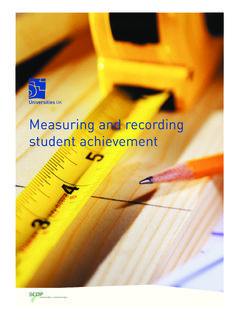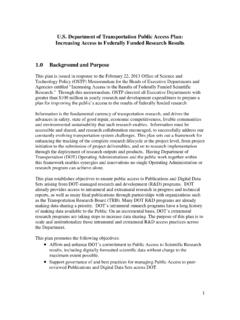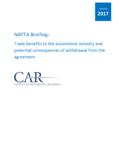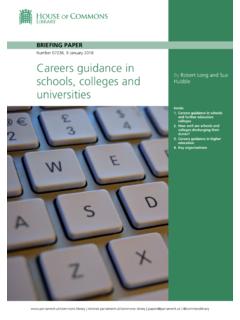Transcription of University funding explained - universitiesuk.ac.uk
1 University funding EXPLAINEDINTRODUCTIONU niversity funding has received a lot of attention in recent years, with the 2012 reforms to higher education and fees across the United of the debate has focused on undergraduate fees and research grants from government with conclusions being drawn on the finances of universities and the possible winners and losers .This is only part of the story. Almost all universities that receive public funding are charities, and raise income from a wide range of sources. This publication illustrates the diversity of these surplus income is reinvested back in to improving teaching and research , and innovating with business to support local and national surpluses, universities would be unable to deliver the scale of investment required to meet student demands, remain internationally competitive and continue to be financially publication explains how universities manage their finances to support their core activities, in both the short and longer term.
2 Finally, it sets out how universities manage risks to ensure they remain sustainable in the long that unless explicitly specified, all 2014 15 figures used in this publication include the impact of a number of universities recognising research and Development Expenditure Credits (RDEC). This was a one-off financial benefit to the sector for 2014 15. Therefore research income, total income, and related surplus(deficit) figures will appear higher (lower) than if the impact of RDEC was +16+44+8+1+21+D UK governmentResearch otherEndowmentOther income 3 TOTAL INCOME FOR 2014 1516 4UK HIGHER EDUCATION INSTITUTIONSIn 2014 15 there were 164 higher education institutions in the UK which received an element of public IN ENGLAND5 IN NORTHERN IRELAND10 IN WALES19 IN SCOTLANDJust over one quarter from direct government sourcesTeaching FeesResearch UK governmentThis publication covers data from all 164 plus the University of Buckingham.
3 It does not include alternative providers in the UK (estimated at 732 in 2014) or further education graduates to meet UK and global demand for higher-level skillsGenerate world-class research that transforms lives Drive innovation that supports local and national economic growthWHAT UNIVERSITIES DO18+47+7+23+5+zFUNDING THE TEACHING OF HIGHLY SKILLED GRADUATESUK government grantsUK & EU fees undergraduates Non-EU feesOther fees and grantsUK & EU fees postgraduates $To be sustainable in the long term, universities need to meet their full economic costs of includes costs of staff, equipment, and services. It also includes the costs of replacing infrastructure and investing in innovation to meet the future needs of students, employers and universities just broke even in covering the full economic costs of teaching UK and EU undergraduate and postgraduate taught students in 2014 18%7%23%47%5%Less than one fifth from direct government sources INCOME FOR TEACHINGS ource thousands UK Government grants 3,326,747 18%UK & EU UG fees 8,424,702 47%UK & EU PG fees 1,200,470 7%Non-EU fees 4,226,479 23%Other fees and grants 877,697 5%Total 18,056,095 INCOME, 2014 MILLIONHIGHER EDUCATION STUDENTS AT UK UNIVERSITIESIN 2014 15 THERE WERE and UK universities received & EU UNDERGRADUATESUK & EU POSTGRADUATESNON-EU UNDERGRADUATES AND POSTGRADUATES379.
4 675students and UK universities received from tuition fees312,010students and UK universities received from tuition feesSome subjects cost more to teach than the University receives from UK and EU students. Government teaching grants are used to close this funding gap. However, income from students and government may still not be enough to cover the costs of teaching some charged to non-EU students are unregulated, and higher than for UK and EU students. This income allows universities to fund activities where costs exceed income for example, teaching of some high-cost subjects and research +2773% came from tuition fees27% came from teaching grantsOF THE WORLD-CLASS RESEARCH66+4+13+11+5+1+z4%11%13%66%6 research INCOME, 2014 15UK governmentUK businessUK charitiesEU sources1% INCOME FOR RESEARCHTwo-thirds from direct government sources5%Other sourcesNon-EU sourcesTo be sustainable in the long term, universities need to cover the full economic costs of conducting research .
5 This includes academic staff, training of postgraduate research students, fieldwork, and laboratory and studio work. It also includes maintaining and replacing infrastructure, and investing in income UK universities received (from government and all other sources) in 2014 15 was not enough to be sustainable. There was a deficit of billion (or billion excluding the one-off impact of R&D Expenditure Credits*).The UK invests significantly less in research and development (R&D) than many other countries. Total UK R&D expenditure is of GDP, well below the OECD average of ,910 Postgraduate research students in the UK, 2014 15*See note on page 2 7(citations per pound spent) THE WORLD AVERAGEUK research PRODUCTIVITY ISUKWORLDUK and EU studentsnon-EU studentsFUNDING INNOVATION TO SUPPORT GROWTHU niversities share their expertise and collaborate with businesses and the wider community this is known as knowledge exchange.
6 Knowledge exchange drives innovation and economic growth both locally and across the UK provide a relatively small amount of funding to support this receive income from knowledge exchange and reinvest this income to support future activities wherever 7+20+36+32+5+D FOR KNOWLEDGE EXCHANGE ACTIVITIES, 2014 1510,8592,517 Number of research contracts with large businessesNumber of research contracts with SMEsIndividualsOtherLarge businessesSMEsPublic and third-sector organisationsHOW UNIVERSITIES MANAGE THEIR FINANCESA lmost all universities that receive public funding are charities and raise income from a wide range of of their income is spent on the day-to-day running costs of providing services for students, conducting research and translating that research to benefit society ( operating expenditure ).What is not spent (a margin of income over expenditure, or surplus ) is reinvested back into providing high-quality services in the includes investment in new teaching spaces and research facilities, and major refurbishment of existing buildings ( capital expenditure ).
7 9 FUNDED FROM INCOME FROM TEACHING, research , KNOWLEDGE EXCHANGE AND OTHER SOURCESFINANCED BY BORROWING, CAPITAL GRANTSEXCELLENT STUDENT EXPERIENCEWORLD-CLASS RESEARCHDRIVING LOCAL GROWTH, SUPPORTING COMMUNITIESOPERATING EXPENDITURE Academic and support staff Running and maintenance of premises Residences and cateringCAPITAL EXPENDITURE New teaching spaces, laboratories, research facilitiesThe vast majority of investment in new facilities and refurbishment is funded by universities themselves. In England, universities expect to finance 75% of their capital expenditure from their own cash by 2017 18, compared with 31% in 2014 15. Borrowing will be the second most important SHORT-TERM OUTLOOK Net liquidity measures the ability of universities to meet their short-term obligations from cash at a particular point in time, and so may fluctuate over the England, for example, net liquidity was around four months (126 days) for universities in 2014 15.
8 This is expected to fall to around two months (67 days) in 2017 , universities in England are not holding large cash reserves. The fall is due to universities increasingly spending their cash on new facilities and CAPITAL EXPENDITURE IS FINANCED IN ENGLANDNET LIQUIDITY, DAYS OF EXPENDITURE126 DAYS2017 18 FORECAST2014 1567 DAYS capital expenditure for universities, of which:Cash from operations31%Mortgages and loans40%Capital grants23%Selling assets6%LONG-TERM OUTLOOKU niversities need to replace existing facilities due to wear and tear over time. They also need to invest in developing new and innovative approaches to meet the future needs of students, employers and investment is needed for refurbishing and building new facilities, and investing in only way many universities can invest more is through surpluses. There is limited government funding , and not all universities are able to borrow more.
9 External borrowing is projected to rise for universities in England to over 30% of income by 2016 the long term, universities will need to maintain and grow their student numbers, including those from outside the EU, to fund increased investment. 11 EXTERNAL BORROWING AS A PERCENTAGE OF INCOME FOR UNIVERSITIES IN ENGLAND2014 RISKS AND CHALLENGES12 SHORT-TERM RISKS TO UNIVERSITIESFLUCTUATIONS IN DEMAND FROM UK AND EU STUDENTSThe deregulated market in undergraduate higher education, demographic changes and increased competition from alternative providers mean that universities face increasing uncertainty in predicting their student numbers from year to year. They also increasingly face costs associated with greater competition (such as marketing).CHANGES IN DEMAND FROM NON-EU STUDENTSR eforms to immigration policy by the government have affected demand from overseas students.
10 Ongoing uncertainty over future policy changes and increased international competition may affect the number of non-EU REDUCTIONS IN PUBLIC FUNDINGG overnment funding for higher education and research is limited, as outlined in the 2015 Comprehensive Spending Review. Teaching funding from direct government grants will fall by 120 million in cash terms by 2019 20. 13 funding PENSION SCHEMESThe Universities Superannuation Scheme (USS), the largest pension scheme in higher education, had an estimated deficit of billion as at 31 March benefit schemes such as USS face ongoing funding challenges due to historically low gilt yields, low interest rates and increasing life USS and other defined benefit schemes have been reformed in recent years, challenges remain. This represents a financial risk to universities, including potential increases in COSTS OF research ACTIVITYTo be sustainable in the long term, universities need to meet their full economic costs of research .

















